Hole in the Clouds
Dec 23, 2010
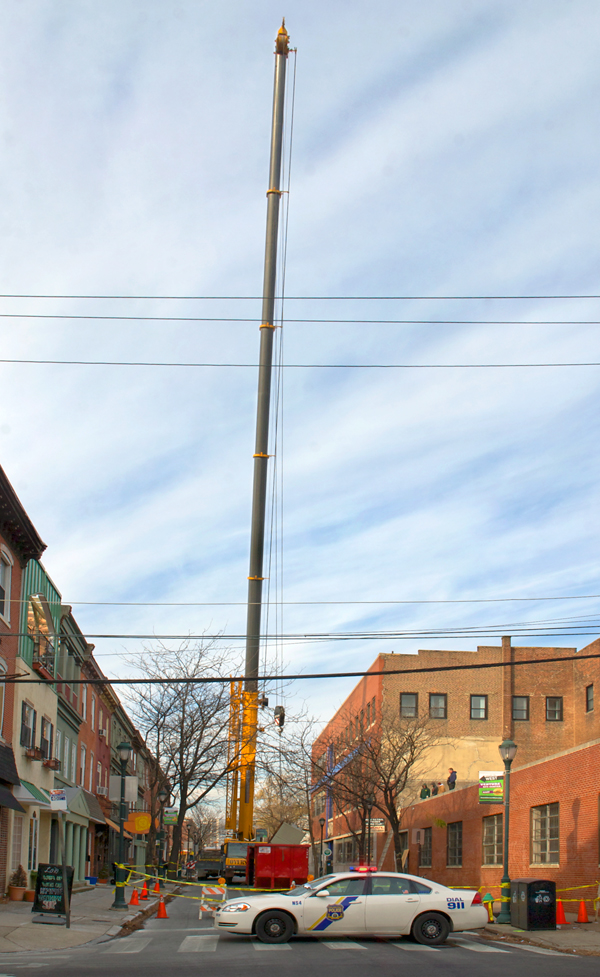
Last Saturday, they closed off a block of South Street around the corner from our house so a crane could pull old equipment up through a hole in the roof of a long-abandoned building. Some people must know why this job required such a tall crane, but I'm not among them.
The rumor is that the building is being refurbished to house a restaurant called Honey Sit n Eat.
streetscape
Philadelphia
crane
Center City
South Street
Feb 25, 2013
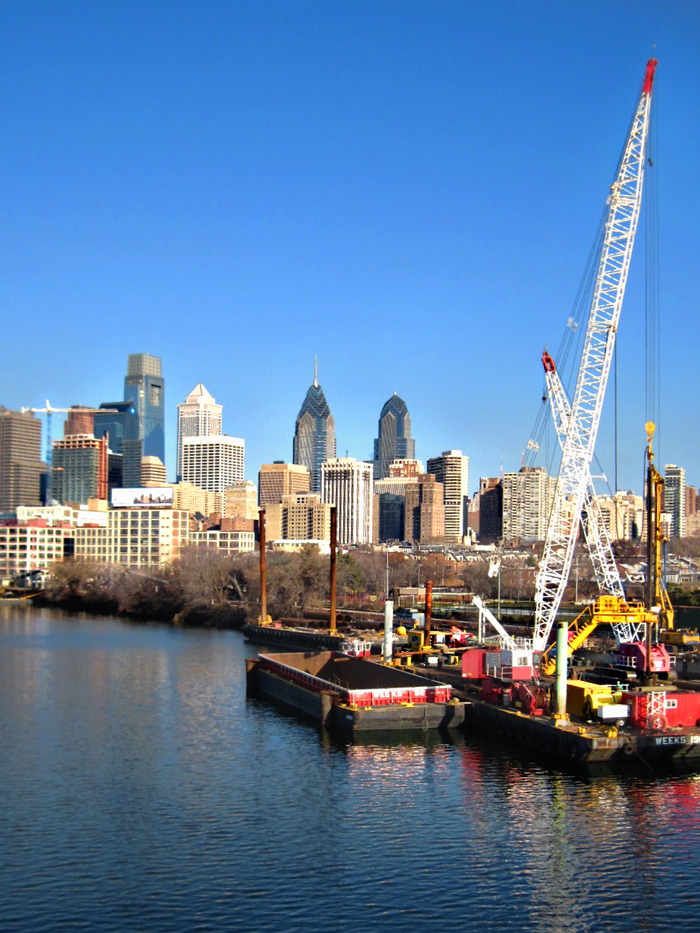 Yesterday, we caught the view from New York City's High Line rails-to-trails boardwalk, a park that winds along the western edge of lower Manhattan, thirty feet up in the sky.
Yesterday, we caught the view from New York City's High Line rails-to-trails boardwalk, a park that winds along the western edge of lower Manhattan, thirty feet up in the sky.
Today's glimpse of a tracks-to-boardwalk project is in Philadelphia, alongside the Schuylkill River, where barge-mounted heavy equipment is currently driving pilings into the riverbed for a boardwalk that will soar out over the water to extend an existing twenty-plus-mile asphalt biking and walking path.
The asphalt path follows an abandoned railroad bed downriver from Valley Forge past Fairmount Park and the Philadelphia Art Museum and on into Center City. But at Locust Street, the trail ends abruptly, crowded off the riverbank by half a dozen railroad lines that are definitely not-yet-abandoned.
The plan is to extend the path southward by snaking it out over the river as a boardwalk with observation platforms and maybe some fishing decks. (Although the Schuylkill is a bit shy of what you'd call a pristine river, there are definitely fish swimming in it, and they are catchable, if not eatable.)
After about half a mile over water, the new boardwalk will pass under the South Street Bridge and then curve back onto dry land for the remainder of its route. It will terminate in southwest Philly at Bartram's Gardens, an eighteenth-century homestead where America's earliest botanists planted the New World's first collection of botanical curiosities.
Planned completion date for the boardwalk is . . . early 2013, or so it is written. Whenever.
cityscape
railroad
Philadelphia
work
Schuylkill River
skyline
crane
barge
(Image credit: Tina Lackeos)
Jan 8, 2014
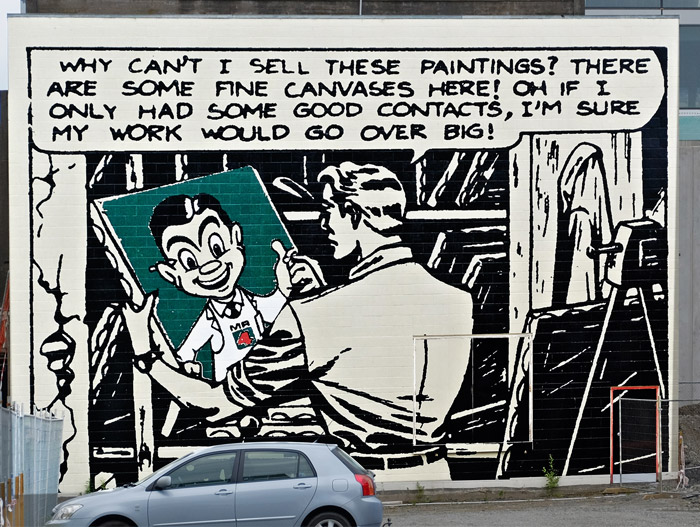 The little guy here in the white apron, with a pencil behind his ear–that's Mr. 4, the grocer-mascot of New Zealand's ubiquitous Four Square chain of supermarkets.
The little guy here in the white apron, with a pencil behind his ear–that's Mr. 4, the grocer-mascot of New Zealand's ubiquitous Four Square chain of supermarkets.
The mural featuring Mr. 4 covers a side wall of the art museum in Christchurch. The museum is closed at the moment and has been for a couple of years. All the artwork currently on exhibit is out in the streets of the city, like this piece.
Perhaps you are wondering why in the picture below there's a crane on top of the museum? Hold that thought; we'll get to it soon.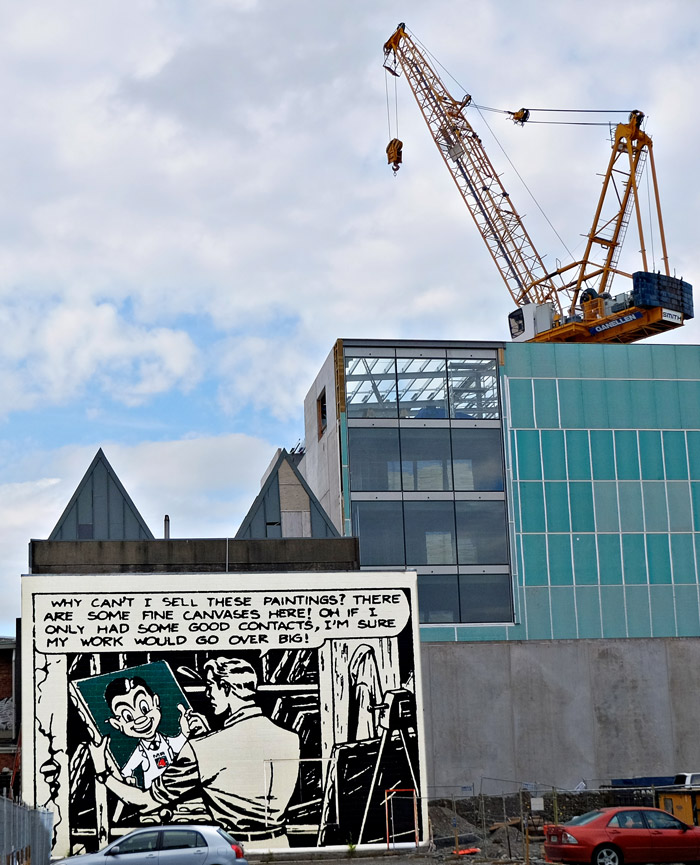
museum
New Zealand
art
streetscape
earthquake
mural
crane
grocery store
logo
Christchurch
(Image credit: Little Fuji)
Aug 25, 2014

This is the story we heard Saturday on the street. Of course, none of it is confirmed.
So. There's this guy who bought a penthouse atop a nice new condo tower on 18th Street, half a block north of Rittenhouse Square. His unit includes a nice big terrace that wraps around at least two sides of the building; his views must include virtually all of downtown Philadelphia and beyond. Expansive, and no doubt expensive.
But not good enough. He didn't like his windows, we're told. He wanted to replace them with better windows and, apparently, more windows. He wanted lots and lots of really, really big windows. Three long trailer trucks full of windows.
Problem was, the new windows wouldn't fit in the elevator to get them up to his penthouse.
He needed a crane, and not just any crane. To operate in the cramped confines of a narrow city street laid out in the days of William Penn, the crane had to lift glass straight up for hundreds of feet and then rotate without bumping into any of the buildings thereabouts and deposit the glass gently on the penthouse terrace. Vehicular traffic could be blocked during this process, but not pedestrian traffic; nearby businesses wanted to keep their doors open the entire time.
There were only three cranes on the east coast, we were told, that could handle this sort of job. One of them was hauled to Rittenhouse Square on Saturday morning. In pieces.
Another crane was needed to help put the big crane together. In case you were wondering, the pieces are held together with big cotter pins.
Police officers were needed to direct traffic around the closed-off block. City buses were rerouted and sometimes delayed, forced into attempting painstaking tight turns onto streets not really suitable for them.
Two large crews of workmen were on duty all day, a crew of heavy equipment guys and a crew of glaziers from Local 262.
So there's the cost of the new windows, and of a rare, expensive crane that had to be assembled by a second crane, plus three tractor trailers to haul in the windows, various vehicles to haul the parts of the cranes, two crews at union wages, lots of expensive permits to block a street and redirect traffic and park all the trucks all day . . .
And then later, after all the new windows are up on the penthouse terrace, there will be the expense of removing the old windows, redoing the walls to accommodate the new windows, installing them . . .
We were told $250,000. Does that sound right to you?
streetscape
work
skyline
crane
Philly
Rittenhouse
abstract
(h/t: C Duffy)
(Image credit: Fuji T)
Aug 26, 2014
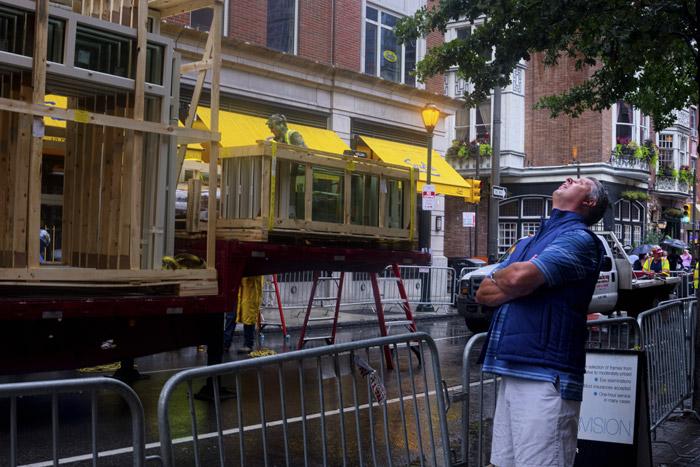 The penthouse dilemma story in yesterday's Good Morning was evidently inaccurate and incomplete.
The penthouse dilemma story in yesterday's Good Morning was evidently inaccurate and incomplete.
Among the dozens of onlookers who spent much of the day Saturday supervising the crane assembly and glass-lifting from the sidewalk was a neighbor, Carolyn, not pictured above, who had the real scoop.
The crane, she reports, arrived on seventeen tractor trailers. The guys assembling it say it's one of three of its kind in the entire country.
And the glassworkers were from Local 252, not 262 as written in these pages.
Several commenters observed that the estimate of a quarter million dollars to pay for new windows was likely on the low side. They believe the actual expense could be two or even three times as high.
But the main thing is: a good time was had by all.

streetscape
crane
Philly
Rittenhouse
penthouse
(Image credit: Fuji T)
Mar 2, 2016
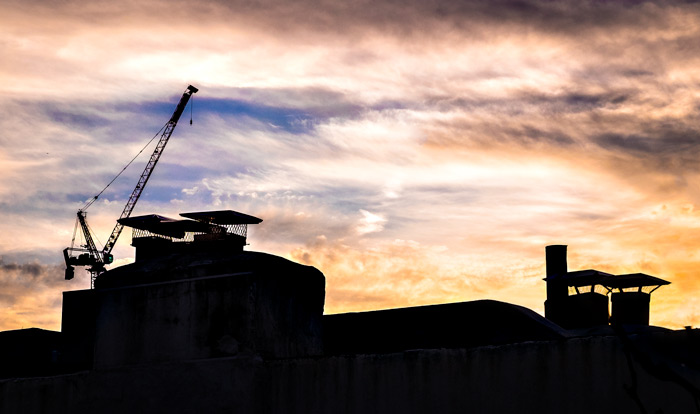 Nothing stays the same. Day goes to night. Some weather's coming in. And off in the distance there's that harbinger of something big in the works–23 stories big, we're told. In a few months, the view out this window should be kinda different. Watch this space.
Nothing stays the same. Day goes to night. Some weather's coming in. And off in the distance there's that harbinger of something big in the works–23 stories big, we're told. In a few months, the view out this window should be kinda different. Watch this space.
sunset
window
crane
roofscape
(Image credit: Fuji T)
Apr 6, 2016
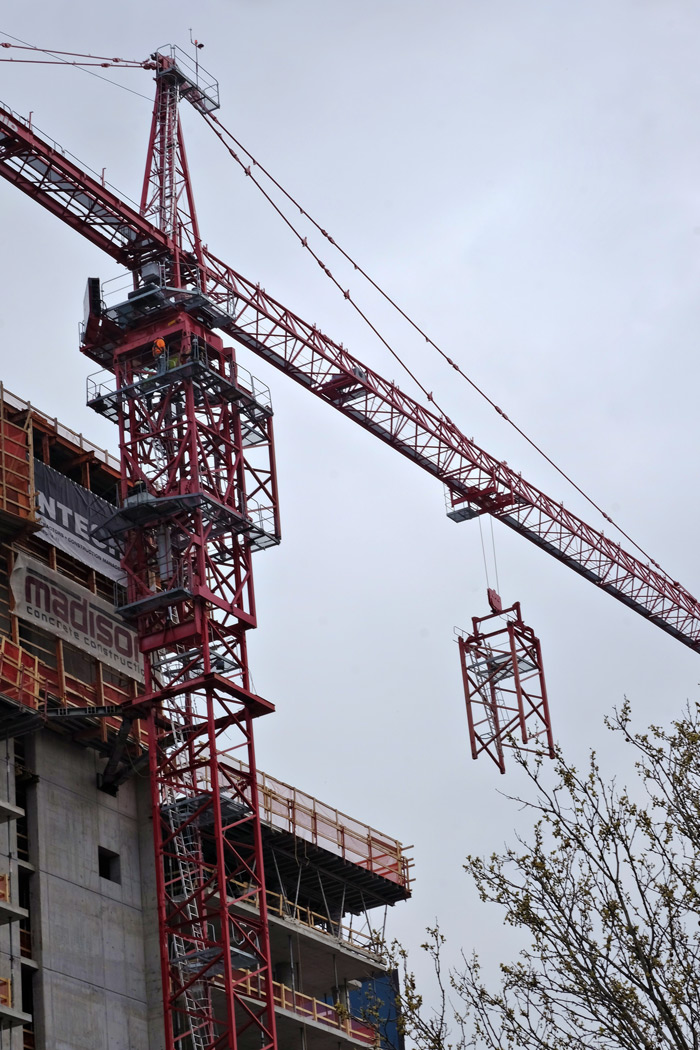 This crane has been caught in the act of growing itself. The object it's lifting into the air is a 20-foot section of crane-tower that it is about to swing into place to lengthen its own neck and make itself taller. The new section will be inserted at the top of the neck, which is currently at a level near the top of the building, where a sort of cage structure surrounds the tower.
This crane has been caught in the act of growing itself. The object it's lifting into the air is a 20-foot section of crane-tower that it is about to swing into place to lengthen its own neck and make itself taller. The new section will be inserted at the top of the neck, which is currently at a level near the top of the building, where a sort of cage structure surrounds the tower.
This cage is called a climbing frame, and it costs $60,000 to rent for a weekend. For a crane that wants to grow itself, the climbing frame is the secret to the whole pulling-itself-up-by-its-own-bootstraps thing.
The climbing frame is installed around the top of the crane's neck, just below the horizontal part of the crane, which does all the heavy lifting. The horizontal arm, with its gears and motor, has to be unbolted from the tower and settled onto the top of the climbing frame. Hydraulic jacks in the frame then boost it up, leaving a gap in the tower. The crane simply picks up a new section of tower and slips it into the gap.
Over the course of a few hours on Monday, this crane grew by six sections, 120 feet. We're told it's now as tall as it needs to be for the project–condos, of course, along the Schuylkill riverfront. In June, the crane guys say they'll be back to dismantle the whole thing and move it to its next job.
How will it ungrow itself? It can't. It's not a cannibal. Sometimes the crane will haul up a second, smaller crane onto the roof of the finished building, and the smaller crane will then lower the pieces of the big crane. To get the second crane down, they sometimes have to use a third, even smaller crane, which can be disassembled into pieces small enough to go down the elevator.

work
construction
crane
condominiums
Schuylkill riverfront
(Image credits: Fuji T)


 The little guy here in the white apron, with a pencil behind his ear–that's Mr. 4, the grocer-mascot of New Zealand's ubiquitous Four Square chain of supermarkets.
The little guy here in the white apron, with a pencil behind his ear–that's Mr. 4, the grocer-mascot of New Zealand's ubiquitous Four Square chain of supermarkets.





